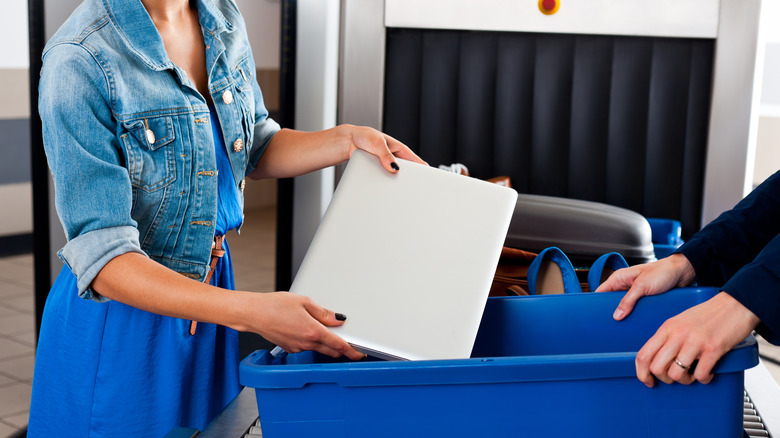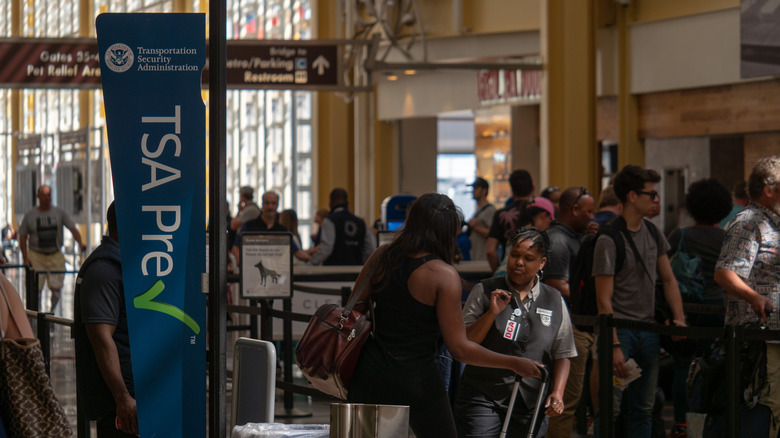We Finally Know Why Some TSA Checkpoints Don't Make You Take Your Laptop Out
Going through airport security can be nerve-racking, even if you have nothing to hide. There are the dreadfully long lines, shouting TSA agents, and those high-tech body scanners. On top of that, the rules sometimes vary depending on the checkpoint, which can create confusion and delays.
Laptop guidelines are one common example of this. In some airports, you might get reprimanded for not taking your laptop out of your carry-on bag, but in others, you may be ordered to keep it packed away to keep the line moving. So what's the deal with the inconsistent procedures that only make going through security even more of a headache?
As it turns out, TSA isn't trying to make your life harder — the agency is actually trying to make the security process smoother by implementing computed tomography (CT) scanners in airports around the country. TSA explains on its website that the machines work just like the CT scanners found in hospitals, creating a 3D image that quickly detects dangerous items. The agency writes, "Under current screening procedures for this technology, laptops are allowed to remain inside the bag for screening." Meanwhile, checkpoints using older machines will still require you to remove your electronics. If you're not sure which is available at your airport, TikToker and flight attendant CiCi in the Sky shares what to look for in a handy video.
Why were laptops removed from bags in the first place?
Currently, TSA's general guidance on laptops is still to remove them from your bag and place them in their own bin for screening. Though the rule may one day be eliminated, it's long been a requirement for an important reason.
Strict laptop guidelines started just after the terrorist attacks of September 11, 2001. Suddenly, business travelers and others who toted laptops along during their trips were required to remove the devices when passing through airport security checkpoints, and the rule has remained in place ever since. The reasoning is that laptops and other electronics contain dense components that standard X-ray machines can't send signals through. As a result, TSA agents can't spot items placed inside or underneath laptops when they're kept inside handbags. Removing these devices helps ensure nothing dangerous is hidden out of sight.
Laptop rules are also in place for the same reason as TSA's liquid rules: A laptop could be used as an explosive. In the early 1990s, passengers were required to power on their devices before boarding planes after a bomb was placed inside a boom box (or a portable sound system, for our younger readers) on a 1989 Pan Am flight. The hidden weapon tragically killed all 259 passengers and 11 people on the ground, revealing how dangerous a single unchecked electronic can be.
There's one way to avoid laptop hassles at any U.S. airport
If you're a frequent flier, or if your local airport still uses outdated scanning machines, you can still avoid the hassle of unpacking your laptop by signing up for TSA PreCheck. CiCi in the Sky recommends the option in her TikTok clip, as do many in the video's comments section. "TSA Precheck is the best money I ever spent!" wrote one user, while another shared they were able to nab the benefit for free with a credit card perk.
According to TSA, those who qualify for TSA PreCheck aren't typically required to remove their laptops, carry-on liquids, shoes, belts, and jackets during security checks. Moreover, PreCheck lines tend to be shorter and move more quickly than regular lines, with the average wait time clocking in at 10 minutes or less. Even if you visit an airport without a PreCheck lane, you'll usually be allowed to pass through security ahead of other travelers.
To enroll, simply apply online and choose a location for an in-person interview. At the interview, be prepared to provide identification documents and a $78 fee, which covers the cost of the Pre-Check designation for five years. As TSA spokesperson Jenny Burke told Forbes, over 99% of applicants are approved, so follow all instructions given and don't stress too much about being rejected.

